AMD Unveils the Radeon Vega Frontier Edition: Vega Starts in the Pros
by Ryan Smith on May 17, 2017 2:45 AM EST- Posted in
- GPUs
- AMD
- Radeon
- Machine Learning
- Vega
- Radeon Pro
- Vega Frontier Edition
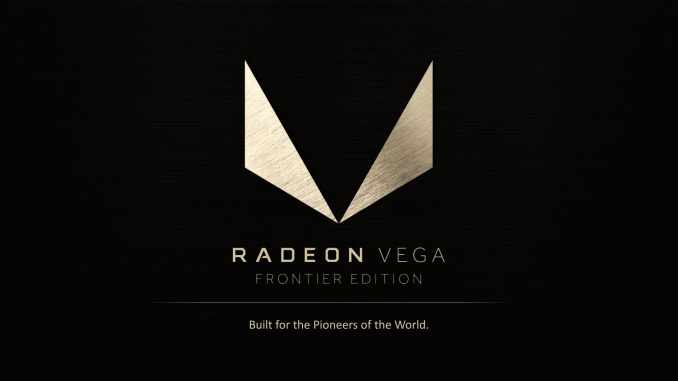
It feels like the build-up to Vega has been just shy of forever. And in a way it has been: AMD first announced the architecture back in March of 2016, and we’ve known for almost as long that Polaris would be a volume play, not a play for the high performance market. It would be Vega that would be AMD’s next high-end GPU, and true successor to 2015’s unique (if mistimed) Fiji GPU.
Since then AMD has slowly been releasing details on the Vega architecture. Bits and pieces related to the Playstation 4 Pro, which incorporated some Vega features, and then a much more significant information dump at the start of this year with their Vega teaser, closely aligned with their associated announcement of the Radeon Instinct accelerator, which set some pretty specific guidelines for what kind of performance AMD was aiming for. Until today all we’ve known for sure is that Vega would be ambitious, but not unrealistic, and that AMD wanted to launch it by the end of June.
So for today’s AMD Financial Analyst Day, AMD has released a little bit more information as part of the next step of their campaign. The first Vega product to be released has a name, it has a design, and it has performance figures. Critically, it even has a release date. I hesitate to call this a full announcement in the typical sense – AMD is still holding some information back until closer to the launch – but we now finally have a clear picture of where the Vega generation kicks off for AMD.
Say hello to the Radeon Vega Frontier Edition.
| AMD Workstation Card Specification Comparison | ||||||
| Radeon Vega Frontier Edition | Radeon Pro Duo (Polaris) | Radeon Pro WX 7100 | Radeon Fury X | |||
| Stream Processors | 4096 | 2 x 2304 | 2304 | 4096 | ||
| Texture Units | ? | 2 x 144 | 144 | 256 | ||
| ROPs | 64? | 2 x 32 | 32 | 64 | ||
| Boost Clock | ~1.59GHz | 1243MHz | 1243MHz | 1050MHz | ||
| Single Precision | ~13 TFLOPS | 11.5 TFLOPS | 5.7 TFLOPS | 8.6 TFLOPS | ||
| Half Precision | ~26 TFLOPS | 11.5 TFLOPS | 5.7 TFLOPS | 8.6 TFLOPS | ||
| Memory Clock | ~1.88Gbps HBM2 | 7Gbps GDDR5 | 7Gbps GDDR5 | 1Gbps HBM | ||
| Memory Bus Width | 2048-bit | 2 x 256-bit | 256-bit | 4096-bit | ||
| Memory Bandwidth | ~480GB/sec | 2x 224GB/sec | 224GB/sec | 512GB/sec | ||
| VRAM | 16GB | 2 x 16GB | 8GB | 4GB | ||
| Typical Board Power | ? | 250W | 130W | 275W | ||
| GPU | Vega (1) | Polaris 10 | Polaris 10 | Fiji | ||
| Architecture | Vega | Polaris | Polaris | GCN 1.2 | ||
| Manufacturing Process | GloFo 14nm | GloFo 14nm | GloFo 14nm | TSMC 28nm | ||
| Launch Date | 06/2017 | 05/2017 | 10/2016 | 06/24/15 | ||
| Launch Price | (A profitable number) | $999 | $649 | $649 | ||
How AMD is going to sell this card and its target market is a huge subject (and arguably the most important aspect of today’s announcement) but I think everyone would rather dive into the specs first. So let’s start there.
The Radeon Vega Frontier Edition is meant to be a powerhouse of a card for AMD. While we’re still not quite sure which Vega chip we’re looking at – AMD has confirmed two chips so far, and it now looks like the second chip is going to be farther down the line – the Vega that we are getting now is AMD’s high-end play. And this is reflected in the Vega Frontier Edition high performance specifications.
AMD previously indicated with the Radeon Instinct MI25 announcement that they would be targeting 25 TFLOPS or better of half precision (FP16) performance on their high-end Vega parts, and the Vega Frontier Edition will be delivering on the “or better” part of that, with performance in the ballpark of 26 TFLOPS. With the caveat that AMD isn’t providing precise numbers at this time – like the Polaris launch, they’re being a bit unspecific – this indicates that AMD is hitting their earlier performance goals.
Furthermore, as part of today’s announcement we finally know that the Vega Frontier Edition will ship with 64 CUs (4096 stream processors), which also allows us to narrow down the clockspeeds of the card. To hit 26 TFLOPS FP16, the card needs to be able to boost to around 1.59GHz. This is particularly notable because AMD’s reference Polaris designs only go to 1.34GHz, which means that AMD is expecting to clock Vega cards a good bit higher than their Polaris cards.
Hitting these high clockspeeds is important for AMD, because while Vega is slated to be a powerful chip, in terms of execution width it’s actually not an especially wide chip. With 64 CUs, the Vega FE is no wider than AMD’s last-generation Fiji-based cards like the Radeon Fury X, which had the same 64 CU configuration. This means that relative to its predecessor, Vega FE is going to rely on the combination of significantly higher clockspeeds and its architectural enhancements to deliver the big performance gains AMD is touting for the card.
Meanwhile, although we now have a good picture of the CU situation for Vega FE, we have a bit of a mystery on our hands with the ROP situation. AMD has not disclosed the number of ROPs, but it has disclosed that the card will have a pixel fillrate of about 90 Gigapixels/second, which doesn’t divide neatly into the earlier clockspeed. It’s quite likely that we’re looking at a 64 ROP design and that AMD’s figures are factoring in a more conservative clockspeed (e.g. the base clock rather than the boost clock). But for the moment, this dichotomy means that the ROP configuration of the Vega FE isn’t as clear as the CU configuration.
Moving on, AMD has confirmed that the Vega FE will have approximately 480GB/sec of memory bandwidth, and in a big surprise, that this will come from 16GB of HBM2 memory. AMD has been heavily promoting their use of HBM2 and what it means for their memory architecture – the High Bandwidth Cache Controller – particularly banking on the fact that the HBM2 specification allows for memory speeds of up to 2Gbps/pin. Coupled with the fact that we’ve already seen an early Vega chip with 2 HBM2 stacks (indicating a 2048-bit bus), and AMD’s figures confirm that they’re going to be coming very close to 2Gbps for the Vega FE. The card’s 480GB/sec of bandwidth means that the HBM2 stacks need to be clocked at 1.875GHz, just short of that 2Gbps figure.
However the far more interesting news here isn’t the bandwidth, but the amount of total HBM2 memory. AMD has revealed that the Vega FE will ship with 16GB of memory, a figure that until today didn’t look to be possible. And to be honest, we’re still not sure how AMD is doing it.
Along with the higher data rate of HBM2, the other major feature of the newer HBM specification is that it allows for much higher capacity stacks, up to 4GB for a 4 layer (4-Hi) stack, or 8GB for an 8 layer (8-Hi) stack, solving the capacity issues that dogged the HBM1-powered Fiji GPU. However to date, neither Samsung nor SK Hynix have offered 8-Hi HBM2 in their parts catalogs. No specific reason has been given, but the use of TSVs means that the greater the number of layers, the harder the memory is to assemble. For the moment, a pair of 8-Hi stacks is by far the most likely explanation for how AMD has put 16GB of VRAM on the Vega FE. However until we hear more from AMD, it’s not the only possibility, and given that 8-Hi HBM2 still isn’t on anyone’s parts list, it may be that AMD has adopted more creative measures to get this much VRAM on a Vega card.
Rounding out the specifications, as AMD’s focus in today’s announcement was on compute performance and memory, the company hasn’t disclosed too much else about the hardware itself. The TDP has not been announced, however as we’re looking at a high-end card, 250W or better is a very good assumption, especially as AMD’s renderings of the Vega FE cards all show the card sporting a pair of 8-pin PCIe power sockets.
What we do know is that there will be two different Vega FE cards, which AMD is calling the Vega Frontier Blue Edition and the Vega Frontier Gold Edition. Information on the differences between these cards is very limited, but from the information AMD has provided, the Blue Edition will be a traditional blower-cooled card, while the Gold Edition will be taking a page from the Radeon Fury X and will feature an external radiator attached via an integrated closed loop liquid cooling system (CLLC). The use of a CLLC on the Fury X in 2015 made it a very quiet card, but at the same time it was also a necessary move due to its 275W TDP. So this may be a sign that the Gold card will have a particularly high TDP.
Otherwise at an architectural level, AMD hasn’t revealed any further details on the Vega architecture, and indeed it’s not clear if there’s much they left uncovered in this winter’s Vega architecture teaser. HBM2, the improved geometry engine, the new FP16-capable CUs, and the tiling rasterizer were all touched upon in today’s announcement. And as mentioned previously, these new architectural optimizations, along with Vega FE’s high clockspeed, are going to be the major components of the card’s performance.
Finally, with today’s announcement AMD has further narrowed down the launch date of their first Vega cards. The Vega Frontier Edition will be the first cards to ship, and as per the company’s earlier promise of an H1’17 launch, the cards will be available in late June. AMD has not announced a price for the cards yet, and like the detailed specifications themselves, I expect we’ll see that closer to next month’s launch.
But what is clear right now is that the Vega Frontier Edition is not meant to be a consumer gaming card, and that takes us into what I think is the more interesting aspect of today’s announcement: the target market.


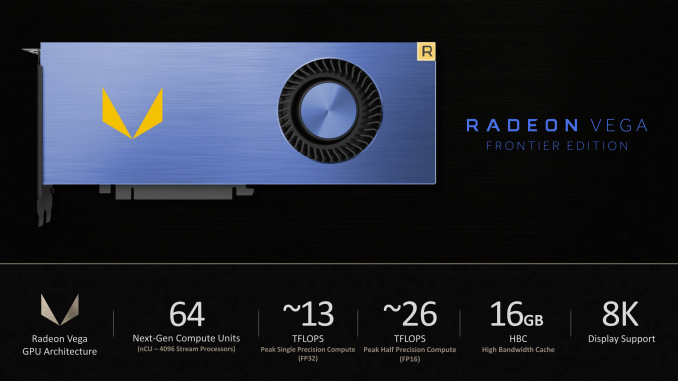
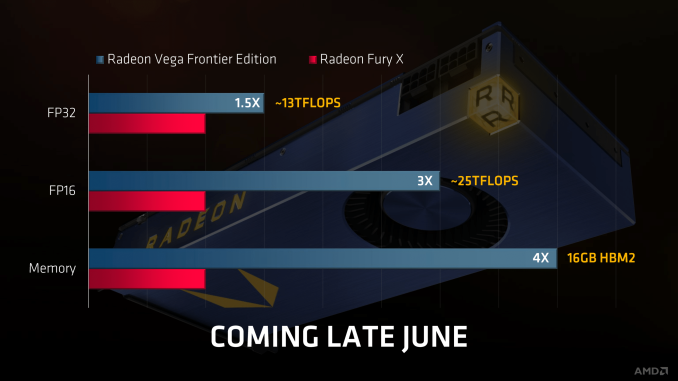
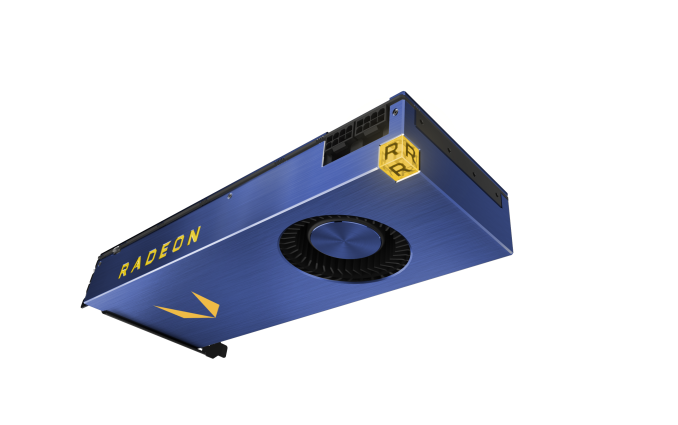
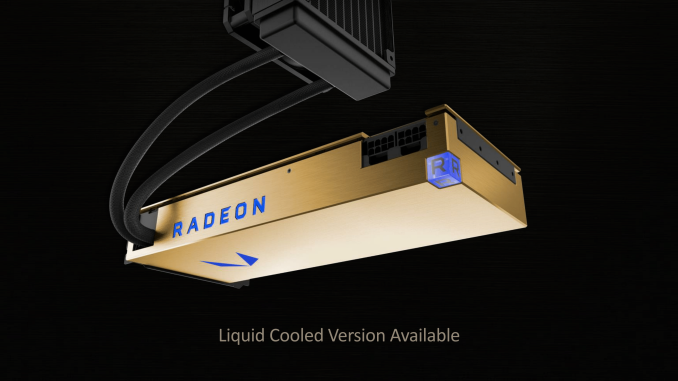
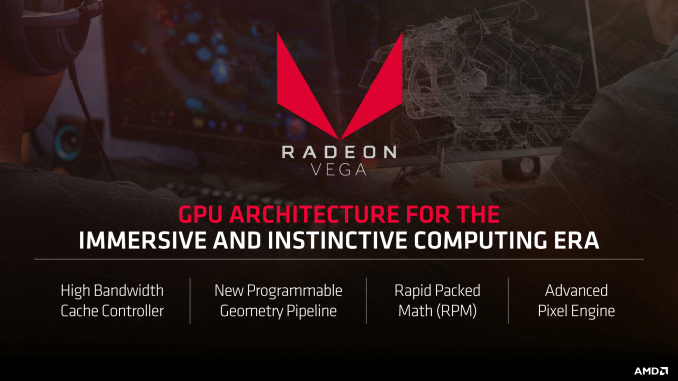








134 Comments
View All Comments
Yojimbo - Friday, May 19, 2017 - link
This claim: "Regarding Google, they seem to have announced a bit of a coup with their tpu2."I think calling it a "bit of a coup" is an overestimation of its likely potential.
"If volta was a better fit for them they wouldn't have needed to create their own asic."
The TPU2 has been in development for 2 years, probably. Without seeing more information about this TPU, how it's actually being used within Google and their cloud, and real-world performance comparisons between the TPU and Volta, you can't assume that the TPU is better. This TPU is an active area of research for Google. It's something they seem to have committed manpower and energy to, and I'm sure it's something they have more plans for in the future. I wouldn't expect them to suddenly find out a few months back "Oh, Volta can do more than we expected, let's just pull the plug on this." So you need more information to make a determination as to what the real world advantages of these TPUs really are.
More importantly you aren't arguing against my point here, since you said "If Volta was a better fit FOR THEM..." (emphasis is mine). My post was focused on the overall machine learning market potential. In fact I said "If the goal is to apply machine learning and only machine learning to a problem, the TPU may be preferable. But if the data should also be processed in other ways, it will probably make more sense to use a GPU." Google is certainly a company that has massive machine learning workloads that consist entirely of machine learning training and inferencing. However, I don't think such workloads will be the majority of machine learning workloads going forwards. That's why, even if this TPU does have a significant price/performance and w/performance advantage over GPUs (and again, what advantage it does have is not clear at this point), it still doesn't qualify as a "coup".
"Also, these new tpus appear to be vastly different from the first gen given that it is end to end sp."
I think it's half-precision not single precision. But in any case, that's actually a disadvantage for the TPU, as I pointed out. They don't give the option for network quantization. The advantage of the end to end half-precision is that they can do both training and inferencing without moving the data around, something that GPUs can also do. GPUs, however, can extend this same advantage to mixed-workload machine learning.
"As I've said, they aren't even competitors right now. So, you don't need to defend the honor of Nvidia to me:)"
This is a counter-productive thing to say. I'm not defending the honor of NVIDIA, I'm analyzing the market.
The TPU looks interesting. Particularly because it's not just an ASIC. It is capable of scaling. So they've done a lot of work on networking and partitioning workloads, etc. As far as NVIDIA is concerned, it is a threat, if only because it means Google will be buying less GPUs from them. It also obviously poses a question for the future of the machine learning compute market: Will ASIC architectures force GPUs out of the majority of machine learning workloads? Calling it a "coup" is an answer to that question implying that it is a significant threat to disrupt the machine learning compute market. I think such a judgment at this point is hyperbolic and unwarranted.
VulkanMan - Wednesday, May 17, 2017 - link
Ryan, the card Raja showed was 8+6 for power. So, the renderings were not correct.https://s12.postimg.org/5ievshwu5/x2_GNw_Bxw2_X-b_...
Ryan Smith - Wednesday, May 17, 2017 - link
The renderings are the images officially released to the press, so they're more likely to be the correct ones. But we shall see. This wouldn't have been the first time someone has held up a dummy card or prototype.VulkanMan - Thursday, May 18, 2017 - link
On Raja's AMA on reddit, he just said: "I grabbed an engineering board from the lab on the way to the Sunnyvale auditorium, and that boards works well with a 6 and an 8 pin. We decided to put two 8 pin connectors in the production boards to give our Frontier users extra headroom"Cellar Door - Wednesday, May 17, 2017 - link
No consumer cards until the 2nd half? That is a fail, fail, fail.The RX5xx series is already a rehash that no one cares about. I'm really hoping Nvidia decides to cease upon this opportunity and do a 1.. 2.. punch with launch of a consumer Volta in the form of a GTX 2080 series card.
At this point it has just been too long and I'm sick and tired of the ridiculous hype train.
HEAR THIS AMD! - I, for one am deciding not to 'hold out' for a little longer, Nvidia is getting my money this year. It's been too long.
MsYunaAyashi - Thursday, May 18, 2017 - link
very well then. Good bye!Onasis - Wednesday, May 17, 2017 - link
Well idk how this is posible but my r9 390 has 125 fps on 2k paired with 7700k stock not hitting 125 but sitting on it. So as far im concerned I dont need vega or volta, but do I want them? Absolutely yes. Besides learning from the history of this two give a month or two after release and u will be buying Vega for 250$Chaser - Wednesday, May 17, 2017 - link
AMD GPUs are becoming 2nd hand junk or vaporware. Only their fanboys care anymore.supdawgwtfd - Wednesday, May 17, 2017 - link
Bahahahaahhaahahhahah!!!!Wow... biased much?
fanofanand - Wednesday, May 24, 2017 - link
I think you accidentally typed in anandtech, when you meant to put in wccftech